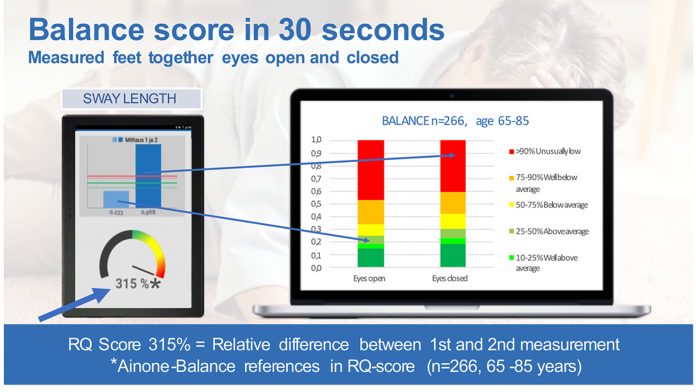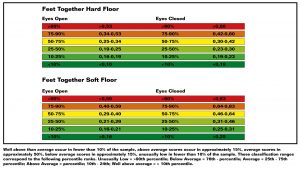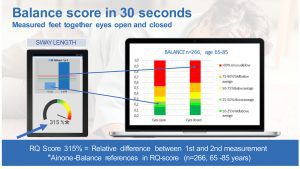
The experts from Ainone discuss how the Romberg test and sensor technology can help to reduce fall risk in the elderly population.
Fall risk is a major global concern due to its prevalence and for the financial and physical costs it has on the elderly population. The growing age-related risk and problems appear to be associated with increasing motor, sensory, and cognitive functions in the elderly population. Studies show that impaired balance is perhaps the most significant factor of falls, explaining up to half of the factors that lead to the risk of falling.
Identifying the link between the risk of a fall and the balance is also important when monitoring the annual costs of hundreds of billions of euros from falls. However, by recognising the risk of imbalance and training, we could already prevent up to a third of falls leading to injuries in the elderly and affect the quality of injuries as well as the costs of serious falls.
The Romberg test and quotient balance measurement
The traditional Romberg test is also frequently used as a part of balance assessments in neurological conditions and for such incidences as sports concussions. The Romberg test is conducted feet together, with eyes open and closed. The influence of eye closing on stability can be expressed using the Romberg’s quotient (RQ), as reported by Van Parys & Njiokiktjien, and Dornan, Fernie, & Holliday in the 1970s. The result of RQ is the relative difference between eyes open and closed tests. Balance tests are normally conducted using stopwatch and error grading, but the test position, such as feet together, in SRC evaluation has also been used in computerised balance testing in different clinical applications, such as for hearing-impaired children, elderly falls, and multiple sclerosis. Computerised force plates offer more precise and objective measurement of balance performance. However, when computerised force plates are used, it is difficult to compare results across studies using different devices. Common denominators, such as the potential RQ, are needed.
Instrumented balance measurement
There is a consensus on the need to screen for balance dysfunctions, but the available methods are largely based on subjectively, classified (i.e., 0-4), and/or qualitatively assessed performances. The instrumented Romberg test using a force plate represents a validated assessment process for the evaluation of balance performances. The purpose of a study carried out by Gallamini et al. (2021) was to propose an innovative instrumental method to identify balance deficits, assess their severity, and give an automated indication of the most likely etiology. The proposed method was applied to the instrumented Romberg test, using force plate data recorded in a cohort of 551 females aged over 65 years participating in adapted physical activity courses. Based on the preliminary findings of the study, the Romberg test could be an efficient and cost-effective mass screening tool for identifying subjects at risk of fall, since the procedure proves to be rapid, non-invasive, and apparently devoid of any contraindications.
Balance measurement using sensor technology
New innovative balance measurement systems and solutions are needed for quick evaluation. A recent article by Kelly et al. (2021) conducted a literature review of human factors and proposed an objective scoring system to evaluate the feasibility of balance assessment technology using sensor technology for adaption into remote rehabilitation settings. The main factors to consider are deployment constraints, usability, comfort, and accuracy. The study stated that, when developing novel balance assessment technology, the key focus areas of the research are improving accuracy, reliability, and validity. In addition, other aspects of usability related to human factors, such as practicality, comfort, and ease of use, need further consideration to help advance the technology to a state where it can be applied in remote rehabilitation settings.
Balance measurement using Ainone Balance®
The Ainone Balance® mobile application for balance measurement (Class I medical device/MDD 93/42/EEC) uses Movesense-based sensor technology. The application is quick and simple, and it can be used anywhere and at any time. Ainone Balance is validated against HUR Balance Trainer and the reliability is proven to be good. The reference values bring added value, for example, in balance measurement detecting falls in the elderly (Fig. 1). Besides the outcome as a balance score in the Romberg test, it also includes a score for RQ. As demonstrated in the example (Figure 2.), you can see the usability of balance sway length measurements, for eyes open the Ainone Balance score is well above average (green = 0.233), for eyes closed (red = 0.968) the score is unusually low and the RQ score is 315% higher – referred to as unusually low score.
Figure 1. Reference Values on Ainone Balance: Age 65-85 years, n=266

Figure 2. Example case utilizing Romberg test score and RQ in balance measurement










